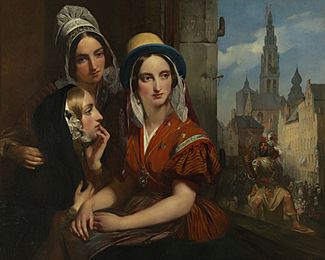Gustaaf Wappers facts for kids
Quick facts for kids
Gustave Wappers
|
|
|---|---|

Self-portrait (1871)
|
|
| Born | 23 August 1803 Antwerp, Belgium
|
| Died | 16 December 1874 (aged 71) Paris, France
|
| Education | Royal Academy of Fine Arts Antwerp |
| Known for | Painting |
| Movement | Romanticism |
Egide Charles Gustave, Baron Wappers (born August 23, 1803 – died December 6, 1874) was a famous Belgian painter. His art is usually seen as part of the Flemish tradition. He often signed his paintings with the Dutch version of his name, Gustaaf Wappers. He played a big role in bringing the exciting Romantic art style to Belgium.
Contents
Biography
Early Life and Training
Gustave Wappers began his art studies at the Royal Academy of Fine Arts in Antwerp. This was a well-known art school in Belgium. In 1826, he traveled to Paris, France.
While in Paris, Wappers saw the rise of the Romantic movement. This was a new way of thinking about art and politics. It focused on strong emotions, dramatic events, and individual freedom.
A New Style of Art
Wappers was one of the first Belgian artists to embrace these new Romantic ideas. His first major painting was called "The Devotion of the Burgomaster of Leiden." It was shown at the Brussels Salon in 1830. This was the same year as the Belgian Revolution, when Belgium fought for its independence.
His painting was very successful and made a big impact. It showed a dramatic historical moment, which was typical of the Romantic style. This work helped change the way Flemish painters approached their art.
Royal Painter and Teacher
Because of his growing fame, Wappers was invited to the royal court in Brussels. He received many important painting jobs from the king. In 1832, the city of Antwerp made him a Professor of Painting.
In 1834, Wappers showed his most famous work. It was called "Episode of the Belgian Revolution of 1830." This large painting showed a key moment from the revolution in Brussels. It is now kept at the Royal Museum of Fine Arts of Belgium.
After this success, he became the official painter to Leopold, King of the Belgians. In 1839, he became the director of the Antwerp Academy. As a teacher, he taught many students who later became famous artists themselves. Some of his notable students included Lawrence Alma-Tadema and Ford Madox Brown.
Later Life and Legacy
Wappers created many paintings throughout his career. Some of his works showed traditional religious scenes. Others focused on historical events, painted in the Romantic style. Examples include "Charles I taking leave of his Children" and "Peter the Great at Saardam."
The French king, Louis Philippe I, asked Wappers to paint a large picture for a gallery in Versailles. This painting, "The Defence of Rhodes by the Knights of St John of Jerusalem," was finished in 1844. In the same year, the Belgian king Leopold I gave Wappers the special title of baron.
Wappers retired from his role at the Antwerp Academy in 1853. He then moved to Paris, France, where he lived until his death in 1874.
Honours
Gustave Wappers received several important honours during his life:
- He was given the title of Baron Wappers.
- He was named the official painter to the King of Belgium.
- He became a member of the Saxe-Ernestine House Order from Saxe-Coburg and Gotha.
- He was made a Knight of the Military Order of Christ in Portugal.
See also
 In Spanish: Gustave Wappers para niños
In Spanish: Gustave Wappers para niños


